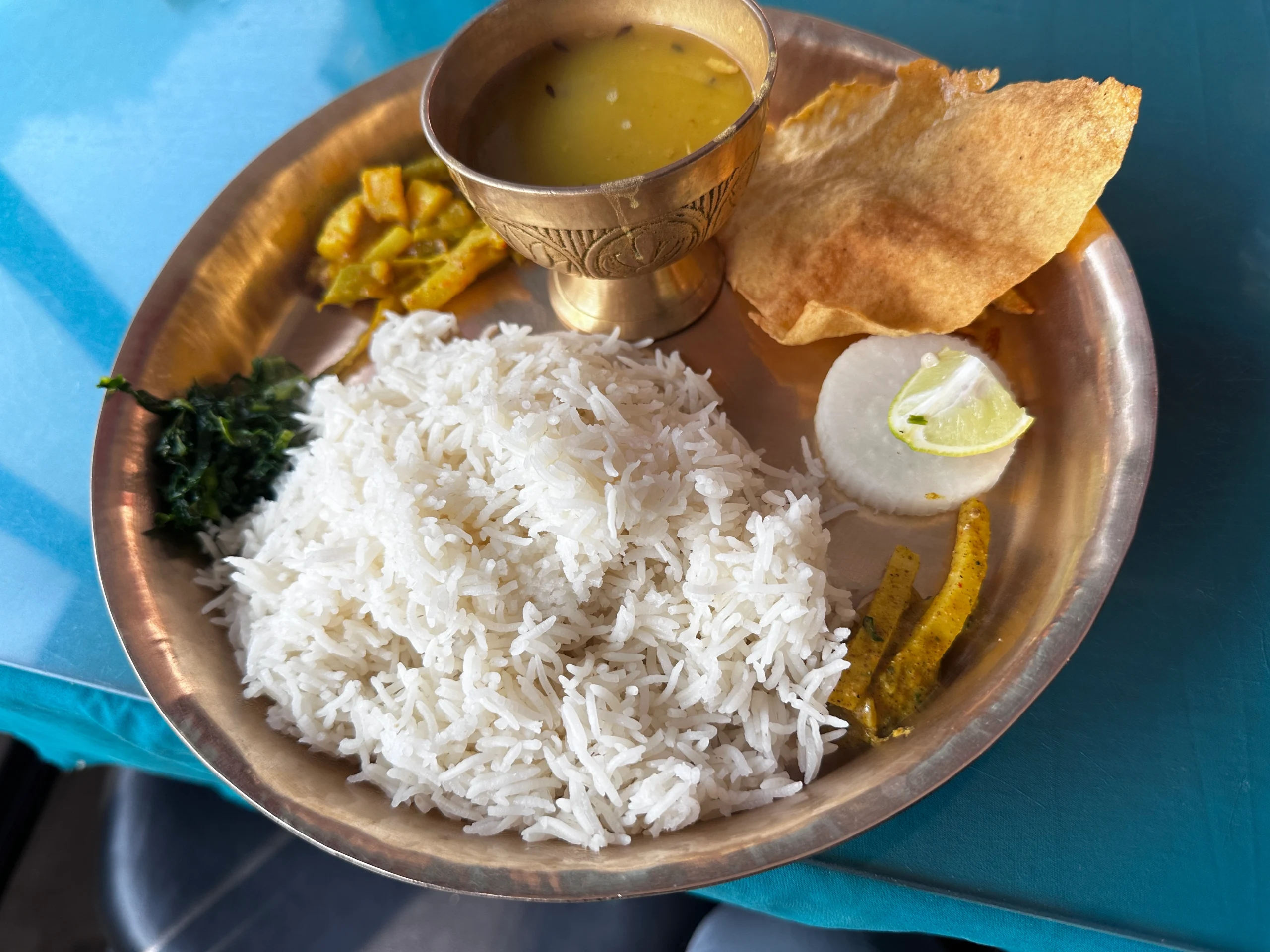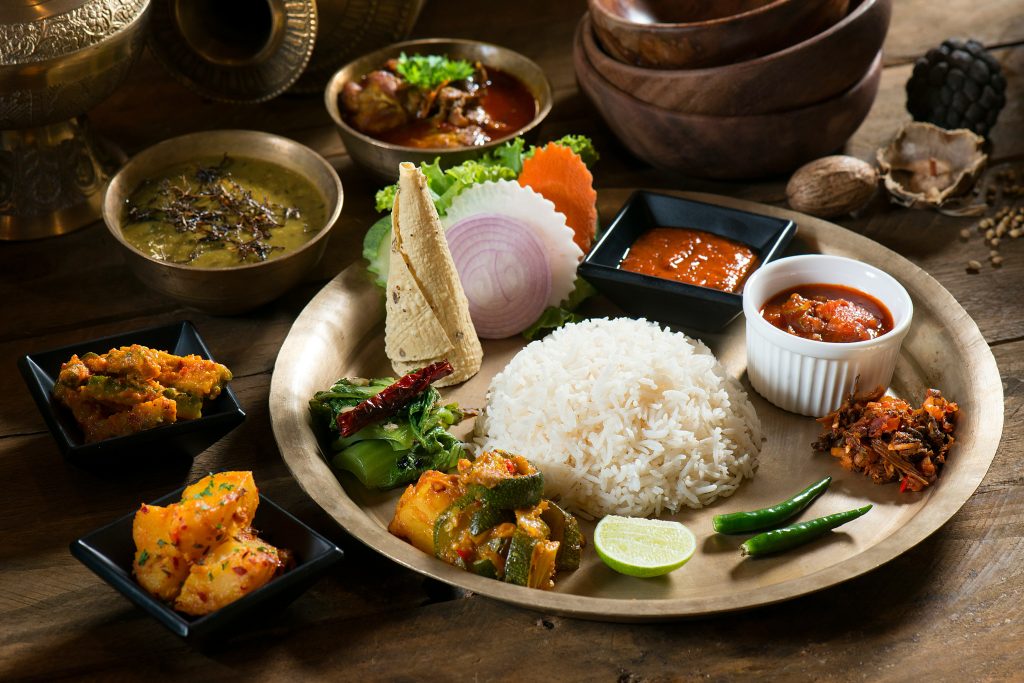
The icy wind is whistling around and giving you the smell of pine trees and snow. You have been walking for hours and hours on a trek, with each step reflecting your power and will. Your legs hurt, your lungs feel burnt, and the surrounding world is beautiful and cruel at the same time. So, what keeps you going? What is your favorite thing to do after a hard, strenuous day on the trail?
To the majority of trekkers in Nepal, the solution is very easy and reassuring: Dal Bhat.
To eat Dal Bhat, you don’t have to visit fancy restaurants or a luxury five-star restaurant. You can find Dal bhat in every corner of the city, from hotels and restaurants to the remote region tea house. Especially people from Western countries, where travelers go to Nepal, might not know about this dish. So today in this blog, we will let you understand what Dal Bhat is.
Understanding: What exactly is Dal Bhat?

Dal Bhat, which is also called the national dish of Nepal, is the meal combination of three things: Dal means “soupy lentils”, bhat means “steamed white rice”, and tarkari means “ cooked vegetables or meats”. Also, Achaar is added to the main dish, which means “pickle”.
- Dal: There are a variety of dals you can find, for example, masoor dal, moong dal, chana dal, toor dal, and black lentils.
- Bhat: Different rice varieties are used in making bhat, like basmati rice, jasmine rice, brown rice, and local Nepali rice.
- Tarkari: This side dish can be anything, for example, potatoes, cauliflower, greens, beans, or chicken curry, mutton curry, pork curry, etc.
- Achaar: To add the taste to Dal bhat, often curry is provided, which can be spicy or tangy (e.g., radish, tomato, chili).
- Sometimes: A small portion of papad (crispy lentil cracker), curd (yogurt), or salad.
Dal Bhat Nutrition Breakdown
| Food Item | Main Nutrients | What It Gives You |
| Dal (Lentil Soup) | Protein, Iron, Fiber, B-vitamins | Helps build muscles, supports energy, good for digestion |
| Bhat (Rice) | Carbohydrates, Small amount of Protein | Gives long-lasting energy for trekking |
| Tarkari (Vegetable Curry) | Vitamins, Minerals, Fiber | Supports immunity and digestion |
| Saag (Green Leafy Veg) | Iron, Calcium, Vitamins A & C | Good for blood health and strengthening bones |
| Achaar (Pickle) | Vitamins, Natural Probiotics, Minerals | Boosts taste and improves gut health |
Why does this unassuming duo rule the trekking world?
Dal bhat is called the power house food in Nepal. It is because this meal has a combination of nutrition, protein, carbohydrates, and other essential minerals. Let’s see why Dal Bhat is so famous not only in homes but also for the trekkers:
The Powerhouse of Energy:
A plain yet strong meal is the Dal Bhat. The rice provides you with instant energy, and you keep on moving for long hours on the trail. These lentils contain plenty of protein and fiber that release energy gradually and make one remain strong all day. Each bite that you take will supply power to your body to walk more and go higher. When every detail counts, Dal Bhat makes you move on.
The Taste of Home in the Mountains
Out of home and comfort, trekkers will be at rest with a warm plate of Dal Bhat. The scent of spiced lentils and the mushy consistency of rice is almost a tiny touch of home, even in the Himalayas. Having encountered cold, wind, and hard climbs, relaxation and joy come with sitting down to this known meal. It is a warm hug, assuring you that you are safe and loved even in the mountains.
The Dish That Adapts Everywhere
Dal Bhat is a common dish in Nepal, and it is cooked in every house of Nepal almost every day. Even though the primary components remain the same (rice, lentils, and curry), the taste remains different in each place you eat. That’s the beauty of Dal Bhat. You can taste different flavours with the same ingredients which will not bother you even if you eat every day. And that’s the reason why people in Nepal eat Dal Bhat every day.
The Budget-Friendly Choice
Exploration in Nepal is quite a costly business, yet Dal Bhat can always be the cheapest meal in any teahouse menu. It is not only satisfying but also good, healthy, and not costly, which is ideal for the trekkers who are traveling under a tight budget. It is also possible to dine well and at the same time spend less, and then have more time to concentrate on the adventure instead of spending time focusing on the money.
The Natural Protector
Dal Bhat is also believed to keep many of these trekkers healthy in the mountains. It is not scientifically proven, but the digestion and preventive measures against stomach issues or altitude unease are supported by the consumption of freshly cooked rice, lentils, and spices such as ginger. That way, it is not only food, but your natural protection against high altitude travelling.
Dal Bhat is more than a meal; in every respect, it is the main part of trekking in Nepal. Healthy, warm, customizable, low-priced, and gives you fresh energy. It is the ultimate Nepal cuisine flavor.
Worth reading: Tea Houses in Nepal: Everything You Need to Know Dal Bhat Price in Nepal
The cost of the Dal Bhat inside Nepal depends on where you are eating. Let’s the average cost of Dal bhat according to the different places:
| Location | Approximate Cost for Dal Bhat |
| Local / small eatery in city | NPR 100 – 300 |
| Mid-range restaurant in Kathmandu / Pokhara | NPR 500 – 800 |
| Trekking teahouses (mid altitudes) | NPR 600 – 900 |
| High altitude trekking (remote, high-altitude lodges) | NPR 1,000 – 1,500 |
| Luxury 5 star hotel( full meal course) | NPR 5000-15,000 |
Frequently Asked Questions
1. What is Dal Bhat?
You can call Dal Bhat the National dish of Nepal. This meal consists of three main components: a mound of steamed rice (bhat), a bowl of fragrant lentil soup (dal), and a side of vegetable curry or stir-fried greens (tarkari).
2. Why is Dal Bhat considered the ideal fuel for trekking?
Trekkers considered Dal Bhat to be the best power pack meal due to it being full of balanced nutrition and slow release energy.
- Sustained Energy: The rice provides complex carbohydrates that are slowly digested, releasing energy gradually throughout the day and preventing sugar crashes.
- Protein Power: The lentils (dal) are an excellent source of plant-based protein. It helps to cure and repair muscles especially during the difficult activity at high-altitude regions.
- Fiber-Rich: The combination of Dal Bhat and Tarkari provides a good amount of fiber in the body. Also, compared to other meals, Dal Bhat is easily digestible and helps to keep your hunger away for a longer time.
3. What makes Dal Bhat so nutritionally complete?
Dal Bhat is a surprisingly well-rounded meal:
4. Carbohydrates: From the rice and sometimes potatoes in the tarkari.
- Protein: Primarily from the dal, with some added from vegetables.
- Fats: Minimal but often present from oil used in cooking or a dollop of ghee (clarified butter) on the rice.
- Vitamins & Minerals: The accompanying tarkari (vegetable curry) and often fresh greens provide essential vitamins, minerals, and antioxidants.
- Hydration: The soupy dal contributes to overall fluid intake, which is vital at altitude.
5. How widely available is Dal Bhat on trekking routes?
You can find Dal Bhat easily in every part of Nepal- from a small tea house in a remote village to popular trekking destinations like the Everest Base Camp Trail and the Annapurna Circuit Trail. Whether you are trekking or climbing, you can guarantee that you will find Dal Bhat even if you are in isolated locations.
6. Is Dal Bhat an affordable option for trekkers?
Dal Bhat is the most economical meal option you can ever find in any trekking tea house menu. The best part is that you can refill unlimited dal bhat to fill your stomach and be full of energy. Budget travellers can take huge advantage of this meal.
Is Dal Bhat generally safe and hygienic to eat during a trek?
Yes, it is safe and hygienic food to eat because it is cooked daily for each fresh meal. Due to this, it decreases foodborne illness. Also, Dal bhat is cooked at a high temperature, killing most pathogens. For vegetables, they also use fresh local ingredients.
7. Are there other food options available on treks, and why choose Dal Bhat?
Yes, most tea houses offer a variety of options aimed at trekkers, including:
- Noodle soups (Thukpa)
- Fried noodles (Chowmein)
- Vegetable fried rice
- Momos (dumplings)
- Spring rolls
- Pasta, pizza, or mashed potatoes (especially in higher, more touristy areas)
- Tibetan bread or chapati with jam/honey/egg
8. While these offer variety, Dal Bhat is often favored because:
- Nutrition: It’s usually the most complete and balanced meal.
- Energy: Provides sustained energy crucial for trekking, whereas many other options are lighter or provide quick bursts of energy.
- Cost & Quantity: Often cheaper and comes with free refills.
- Reliability: Always available and generally safest.
9. Does eating Dal Bhat offer a cultural experience?
Absolutely! Eating Dal Bhat is an integral part of experiencing Nepali culture. It’s how local porters, guides, and villagers eat every day. Sharing a meal of Dal Bhat with locals offers a sense of connection and authenticity that other dishes might not provide. It’s a taste of Nepal, literally.
10. Any tips for enjoying Dal Bhat on a trek?
If you are going to eat the Dal Bhat in Nepal, then make sure to do these things:
- Mix it Up: Don’t eat components separately. Mix the dal, rice, tarkari, and a bit of pickle for a harmonious flavor.
- Spice it Right: If you like heat, ask for extra green chilies or chili paste.
- Add Ghee: A dollop of ghee (clarified butter) on your rice can add flavor and a little extra energy.
- Don’t Rush: Enjoy every bite of Dal Bhat without rushing.
Final Say
Dal Bhat is ubiquitous. Nepal is the only country that eats Dal Bhat the most, and there’s even a famous local saying, “Dal Bhat Power 24 hours“. Everyone loves Dal Bhat here. So if you are going to visit Nepal, you must try Dal Bhat once in your life.
You’ll find Dal Bhat almost anywhere — from small restaurants in the cities to teahouses along trekking trails. Even during the Everest Expedition, climbers enjoy Dal Bhat for its strength and comfort. It’s more than just food; it’s a part of Nepali life and culture.
Posted on
